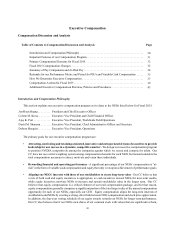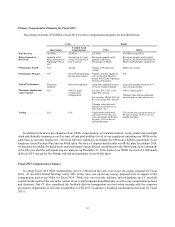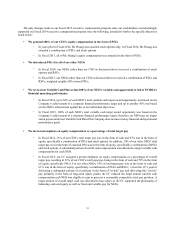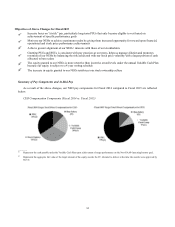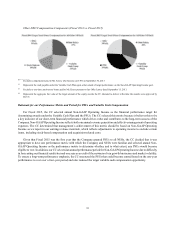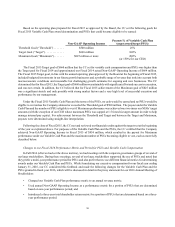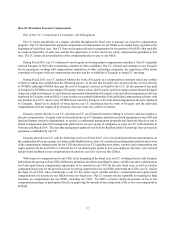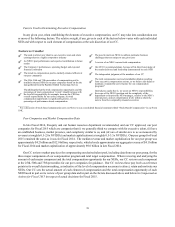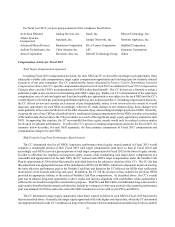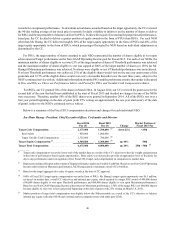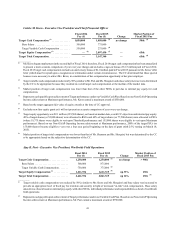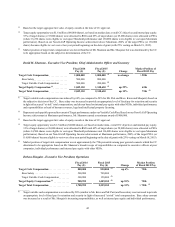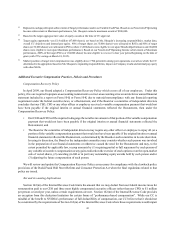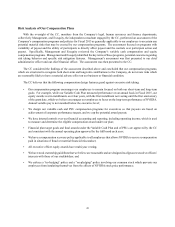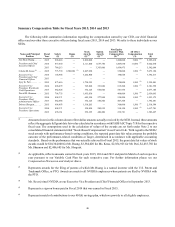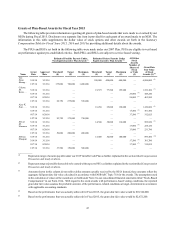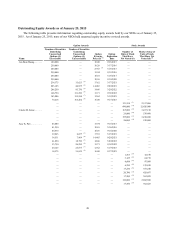NVIDIA 2015 Annual Report Download - page 56
Download and view the complete annual report
Please find page 56 of the 2015 NVIDIA annual report below. You can navigate through the pages in the report by either clicking on the pages listed below, or by using the keyword search tool below to find specific information within the annual report.39
For fiscal year 2015, our peer group consisted of the companies listed below:
Activision Blizzard Analog Devices, Inc. Intuit, Inc. Micron Technology, Inc.
Adobe Systems,
Incorporated Autodesk, Inc. Juniper Networks, Inc. Network Appliance, Inc.
Advanced Micro Devices Broadcom Corporation KLA-Tencor Corporation SanDisk Corporation
Agilent Technologies, Inc. Citrix Systems Inc. LSI Symantec Corporation
Altera Corporation Electronic Arts, Inc. Marvell Technology Group Xilinx
Compensation Actions for Fiscal 2015
Total Target Compensation Approach
In making Fiscal 2015 compensation decisions, for each NEO our CC reviewed the total target cash opportunity (base
salary plus variable cash compensation), target equity compensation opportunity and total target pay for similarly situated
executives of our peer companies. The CC considered the factors discussed in Factors Used in Determining Executive
Compensation above, the CC’s specific compensation objectives for Fiscal 2015 as outlined in Fiscal 2015 Compensation
Changes above and the CEO’s recommendation for NEOs (other than himself). Our CC did not use a formula or assign a
particular weight to any one factor in determining each NEO’s target pay. Rather, our CC’s determination of the total target
compensation, mix of cash and equity and fixed and variable pay opportunities was subjective for each NEO and the CC’s
overall objectives for total pay positioning and balancing the pay mix as discussed above. In making compensation decisions,
the CC did not review and consider each element of pay independently; rather, it was reviewed in the context of overall
target pay opportunity for each NEO. Accordingly, when the CC made changes to one element of pay, those changes were
made primarily in the context of the levels of the other elements of pay, and resulting total target pay for such NEO. Generally,
except in the case of our CEO (as described below), resulting total target compensation for the NEOs was above the median
of the market data (but not above the 75th percentile) as a result of the significant target equity opportunity awarded to each
NEO. In approving this structure, the CC was mindful that these equity awards would only be realized at above-market
levels upon exceptional performance. To reflect the CC’s process in making compensation decisions for Fiscal 2015, the
summary below describes, for each NEO separately, the three primary components of Fiscal 2015 compensation and
compensation changes for such NEO.
Shift Towards Long-Term Performance-Based Awards
The CC determined that for all NEOs, long-term, performance-based equity awards granted in Fiscal 2015 would
comprise a meaningful portion of their Fiscal 2015 total target compensation (and more so than in Fiscal 2014) and
accordingly each NEO received a greater portion of total target compensation for Fiscal 2015 in the form of equity awards.
In order to effectuate the emphasis on long-term equity awards, while maintaining total target direct compensation at a
reasonable and appropriate level for each NEO, the CC reduced each NEO’s target compensation under the Variable Cash
Plan by approximately 50% (which fluctuated by individual based on the subjective decision of the CC). The CC felt that
this adjustment was appropriate because of the introduction of PSUs for all NEOs, which were dependent in part on meeting
the same objective performance goal as the Variable Cash Plan, and therefore the CC believed our NEOs were sufficiently
motivated to work towards achieving such goal. In addition, the CC felt the increase in base salaries for all of our NEOs
provided an appropriate balance to the reduced Variable Cash Plan compensation. As described above, the CC’s overall
goal was to enhance long-term opportunity to drive results and increase alignment with stockholders while maintaining a
sufficient level of cash for competitive and retentive purposes. The PSUs and RSUs delivered additional long-term incentive
and retentive benefits (that the annual cash incentive lacked) by vesting over a four-year period, to the extent the performance
goal was attained (for PSUs) and to the extent the NEO remained in service with us (for PSUs and RSUs).
The CC determined a target equity opportunity value that it wanted to deliver to each NEO in Fiscal 2015 based on the
factors described above. Generally, this target equity opportunity fell at the higher end of peer data, which the CC determined
was appropriate based on the CC’s emphasis on long-term performance-based compensation and allowing for above-market



